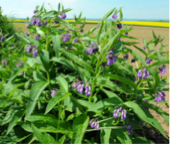Some useful information of a common herb
Common name: Comfrey (knitbone, boneset)
Proper name: Symphytum officinale
Description
It’s a member of the borage family, a strong-growing perennial herb with hairy broad leaves 12 to 18 inches (30 to 45 cm) long. The flower is a pretty blue bell, fading to pink. The plant reaches a height of over 2 feet (60 cm), spreads to more than a yard across and has thick roots.
Distribution
It is native to Europe, growing in damp, grassy places. The experiences have proofed that it also grows in South Africa.
Growing your own Comfrey
New plants can be successfully grown from root cuttings. It is also advisable to grow comfrey in a container as it has a deep root system, making the plant nearly impossible to remove from the garden as new plants regrow from any root stumps left in the soil. Keep comfrey well-watered during the growing season if you plan to harvest leaves from it. But of course you can also plant a root segment directly in your garden whenever the soil can be worked. They should be buried about 2 inches (5 cm) deep. If you already have a strongly growing plant you cut with a spade a piece of root and bury it in the soil. The original plant will quickly recover. Keep the bed well watered until the young plants are established. As easy comfrey is to grow, it does need good soil. You can enrich your patch with manure.
Comfrey should not harvested in its first season as it needs to become established.
Medicinal uses
Comfrey has an ancient reputation as a mender of broken bones. Generally a strong infusion (strong tea) of fresh or dried leaves, either to soak a part such as a sore finger or to dab on a cut with cotton. Crushed foliage can be applied externally.
The most common medicinal use of comfrey are in poultice to help heal swellings, inflammations and sores. To make such a dressing, let the leaves mush up in hot water, squeeze out the excess of liquid and wrap several handfuls of the hot, softened foliage in a clean cloth. Apply the pad to the affected part – comfortably hot, but not scalding – and cover the area with a thick folded towel to keep the heat in.
Fertiliser uses
Compost activator: include comfrey in the compost heap but not in a big quantity as it will quickly break down into a dark sludgy liquid that needs to be balanced with more fibrous material.
Liquid fertiliser: can be produced by rotting leaves in rainwater for 4-5 weeks to produce a ready-to-use fertiliser.
Mulch: a 2 inch (5 cm) layer of comfrey leaves placed around a plant will slowly release plant nutrients. The leaves can be cut to small pieces before application.
Harvesting Comfrey leaves
Cut the plant about 2 inches (5 cm) above the ground. It is advisable to wear gloves as the leaves and stems are covered with hair that can irritate the skin. The foliage is at its best if cut before blooming time. They have a high moisture content and dry more slowly than some of the herbs you maybe used to working with. Dry them in the shade in an airy place and make sure that the leaves are crumbly before you pack them into jars, since any remaining dampness will cause mold.
After such a harvest the plants will grow enough to be cut again in about 2 weeks.
Attention
Comfrey should never be ingested as it contains dangerous amounts of hepatotoxic elements.


